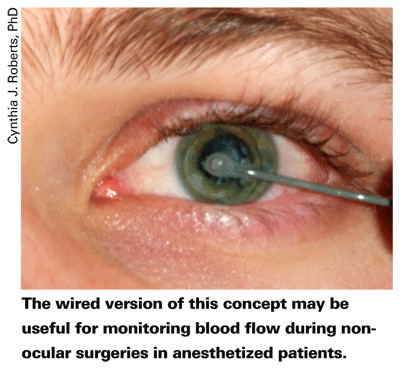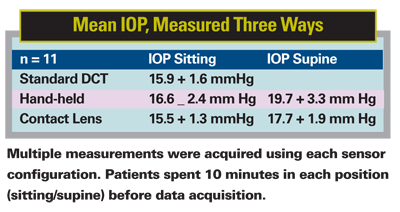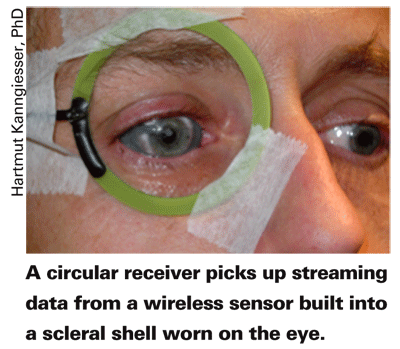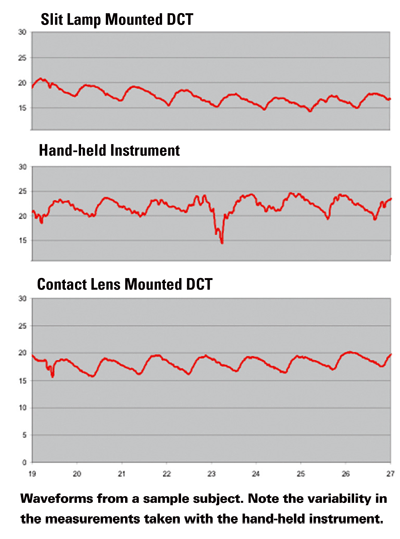Given the fact that intraocular pressure may vary substantially from what you measure in your office—particularly overnight—glaucoma specialists have eagerly awaited the ability to monitor IOP around the clock. Several approaches to this are currently under investigation; one of the most promising is a contact-lens-based IOP monitoring system. Two versions of this are in development in association with Ziemer Group AG in
Getting Wired
Cynthia J. Roberts, PhD, professor and Martha G. and Milton Staub Chair for Research in Ophthalmology—as well as professor of biomedical engineering—at 
Dr. Roberts recently tested the accuracy of the embedded sensor by comparing its readings to those of a standard slit lamp-mounted DCT and a handheld version of the DCT, in which the tip of the Pascal instrument is mounted on a Perkins tonometer. Measurements were taken using all three devices with the patient sitting up; with the patient supine, measurements were taken using the contact lens and handheld unit. "The contact lens sensor produced statistically significantly different measurements from those of the handheld instrument," she says, "but neither was significantly different from the standard slit lamp-mounted instrument measurements. (See chart, below.) In general, the contact lens measurements were closer to the magnitude of the standard instrument and showed much less variability than the handheld unit." She notes that the data consistently showed higher IOP when subjects were supine, an observation that has been confirmed many times in the literature.
"Overall," she continues, "the contact lens works very well. It's very easy to use and is much less variable than the handheld unit because it stays on the cornea. [See sample waveforms, bottom.] It produces reliable IOP readings that compare to the standard slit lamp-mounted DCT.
"Obviously, for glaucoma clinical use, we'll have to get rid of the wire, which is what the team in 
For now, Dr. Roberts is proceeding with an approved protocol for studies in the operating room that will investigate the effect of systemic blood pressure and ocular rigidity on ocular pulse amplitude, which she believes could also be of value in glaucoma treatment.
Going Wireless
Hartmut Kanngiesser, PhD, manager of research and development at Ziemer Group AG, is developing a wireless version of the contact lens device using the same Pascal DCT sensor. He presented some of his early test results at the International Glaucoma Society meeting in
Dr. Kanngiesser says that the current prototype is too large to legitimately be considered a contact lens. "I took a standard scleral shell and made changes to it to implement the wireless capability," he explains. "The wireless components involve a printed circuit board, and right now they take up too much volume to fit in a standard contact lens. This is not the way to go later on; we did it to show that it's possible to do it using wireless connections.
"The pressure sensor gives you a true readout of any pressure changes that happen in the eye, both short-term and long-term," he continues. "The sensor measures 50 times a second in the current wireless setup and 100 times per second in the model with the wire connection. That generates a lot of data; you can follow every heartbeat on the pressure curve."
According to Dr. Kanngiesser, the wireless prototype is comfortable on the eye, and so far works well. "The receiver is a flexible coil that can be placed in the rim of a pair of glasses or attached to the skin with medical tape while you're sleeping. [See picture, above.] The coil is connected by a wire to a receiver, about 2 cm by 5 cm, that you can keep in your pocket. The receiver can store the data or transmit it by Bluetooth or any other wireless connection to a computer. In our current setup, it's connected by a serial USB connection."
So far, the device has been tested on the eye for a maximum of half an hour. "We haven't investigated the oxygen transmission rate or related concerns yet," he notes. "In the next version we'll work together with contact lens manufacturers and use materials that are already proven to be safe for contact lenses. Ultimately, we'd like to be able to leave the device in the eye overnight. If you can't do that, the project doesn't make much sense."
Dr. Kanngiesser says how long the device will take to become a commercially available product depends on how high a priority the project becomes at Ziemer, and how much interest is shown in the market. "It could be ready in two years," he estimates. "But many factors will affect how quickly development happens."



